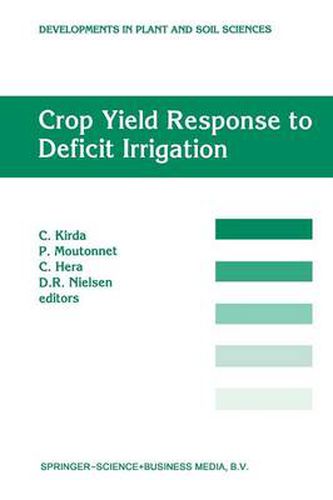Readings Newsletter
Become a Readings Member to make your shopping experience even easier.
Sign in or sign up for free!
You’re not far away from qualifying for FREE standard shipping within Australia
You’ve qualified for FREE standard shipping within Australia
The cart is loading…






This title is printed to order. This book may have been self-published. If so, we cannot guarantee the quality of the content. In the main most books will have gone through the editing process however some may not. We therefore suggest that you be aware of this before ordering this book. If in doubt check either the author or publisher’s details as we are unable to accept any returns unless they are faulty. Please contact us if you have any questions.
The increasing global demand for food and other agricultural products calls for urgent measures to increase water use efficiency which is, with plant nutrient availability, one of the two main limiting factors in crop production. Although only 20% of all cultivated land in the world is under irrigation, it provides 35-40% of all crop production. Because of higher yields under irrigated agriculture, investments for irrigation are usually a top priority. However, it has become a matter of serious concern in recent years that, despite their high co~ts, the performance of many irrigation projects has fallen short of expectations as a result of inadequate water management at both farm and system levels. Crop production increase has been well below the project targets. The greatest potential for increasing food and other agricultural products is the more efficient use of naturally occurring precipitation in conjunction with improved soil fertility management. Until recently, regardless of the amounts and distribution of rainfall, irrigation practices were used almost exclusively to supplement the amount of soil water stored in the root zone to such an extent that the available soil water never allowed the crop to suffer from water stress throughout the growing season. As a result, even today farmers still tend to over-irrigate to ensure a bountiful amount of water stored.
$9.00 standard shipping within Australia
FREE standard shipping within Australia for orders over $100.00
Express & International shipping calculated at checkout
This title is printed to order. This book may have been self-published. If so, we cannot guarantee the quality of the content. In the main most books will have gone through the editing process however some may not. We therefore suggest that you be aware of this before ordering this book. If in doubt check either the author or publisher’s details as we are unable to accept any returns unless they are faulty. Please contact us if you have any questions.
The increasing global demand for food and other agricultural products calls for urgent measures to increase water use efficiency which is, with plant nutrient availability, one of the two main limiting factors in crop production. Although only 20% of all cultivated land in the world is under irrigation, it provides 35-40% of all crop production. Because of higher yields under irrigated agriculture, investments for irrigation are usually a top priority. However, it has become a matter of serious concern in recent years that, despite their high co~ts, the performance of many irrigation projects has fallen short of expectations as a result of inadequate water management at both farm and system levels. Crop production increase has been well below the project targets. The greatest potential for increasing food and other agricultural products is the more efficient use of naturally occurring precipitation in conjunction with improved soil fertility management. Until recently, regardless of the amounts and distribution of rainfall, irrigation practices were used almost exclusively to supplement the amount of soil water stored in the root zone to such an extent that the available soil water never allowed the crop to suffer from water stress throughout the growing season. As a result, even today farmers still tend to over-irrigate to ensure a bountiful amount of water stored.